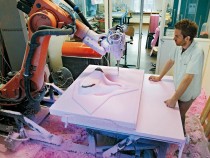
© Vienna University of Technology, 3D Design and Modeling
Digital design tools that make it possible to develop complex geometries have been available for some time now. The computer – a meta-tool – provides great opportunities to develop free-form surfaces; now geometry places nearly no limits on architectural designs. Architecture schools, of course, also utilize these opportunities. We have, nevertheless, noticed that in the design process, students often restrict themselves to the digital realm. But in the interfaces available at present, form, space and scale can neither be perceived nor evaluated satisfactorily in the digital depiction. The option to work intuitively on the physical object is lacking. Our hands and eyes are at risk of becoming mere interfaces with the virtual surroundings. A digital model depicted as a two-dimensional projection on the computer screen or a print-out is not satisfactory.






